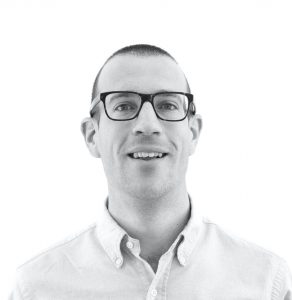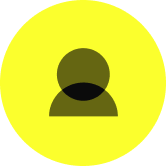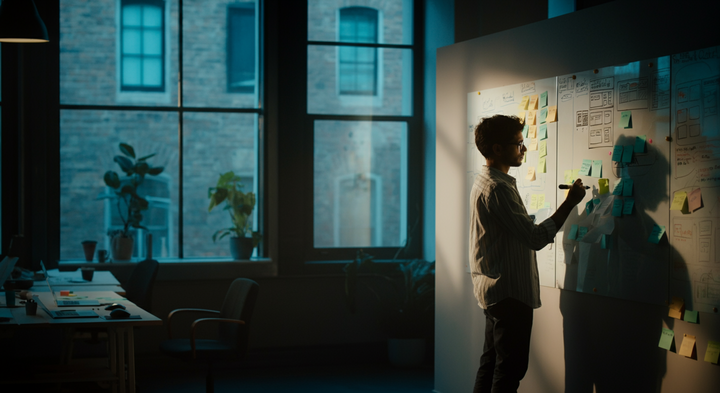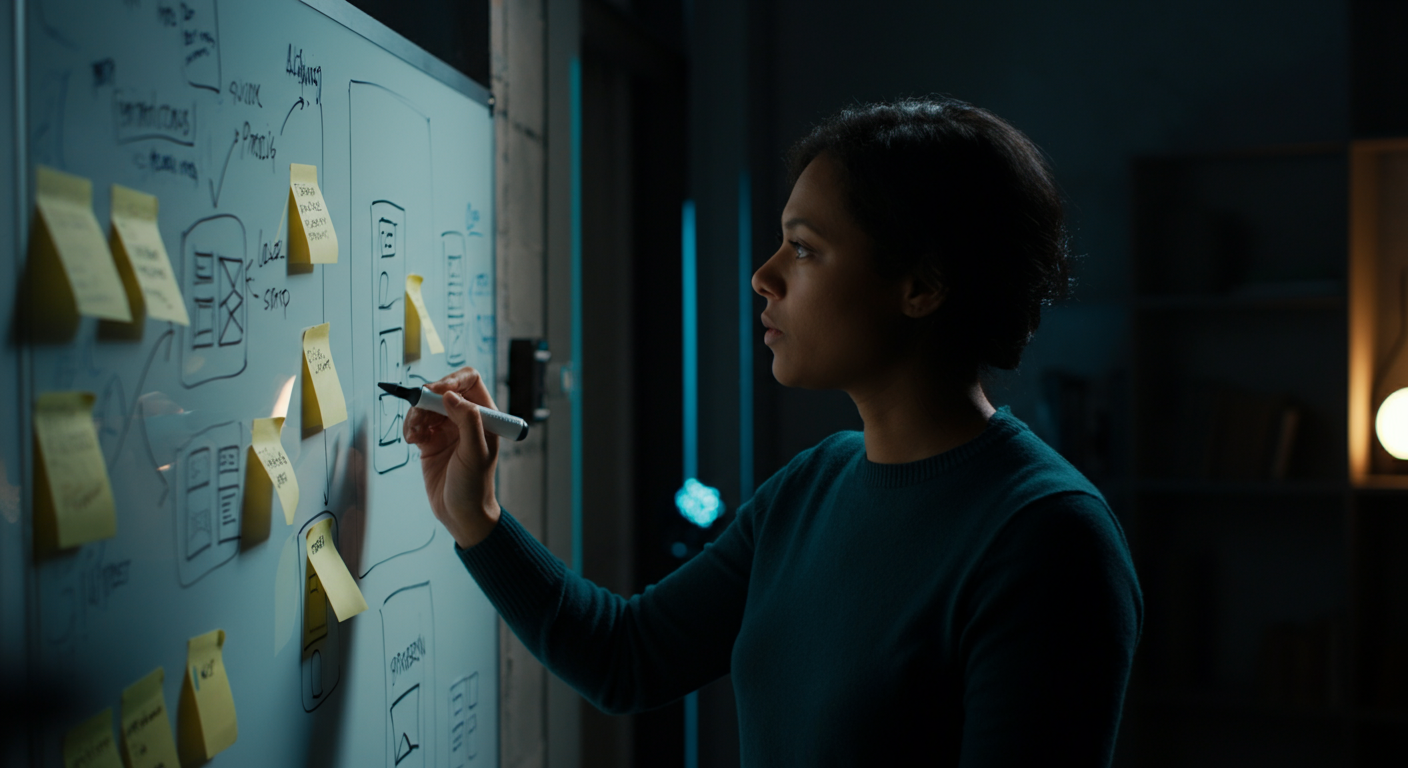Ask a UX’er with
Neil Sampson.
In this series, we interview a wide range of Experience Design professionals from across the industry. From looking down on top as a design leader, to looking up as an entry-level junior. Talking about people’s journeys, day-to-day working lives, key trends and advice.
In the first of the series, we welcome Neil Sampson, Head of UX at design firm Matter Of Form.
Over the last 10 years, Neil has worked client-side at incredible brands such as Farfetch, Kurt Geiger and Dunelm. He’s also worked on the agency side on projects for OFFICE, Carlsberg, Aesop, Pitney Bowes, Vashi, Borough Kitchen, The Collective, Travel Corporation, Lindblad, Guest.com.
So firstly Neil, tell us a little bit about yourself, where you started out and your journey up until now?
 I studied a degree in Web Technology at Lincoln University which covered development, traditional computing, business studies and at the time, a discipline called HCI – Human Computer Interaction. Essentially, HCI is what UX has evolved into now. It’s about how people behave with digital mediums. So during that time, I learned the basics and foundations of what UX is today – about people’s behaviours and how to apply empathy to projects. But the natural evolution of that wasn’t straight into UX… It was actually into development.
I studied a degree in Web Technology at Lincoln University which covered development, traditional computing, business studies and at the time, a discipline called HCI – Human Computer Interaction. Essentially, HCI is what UX has evolved into now. It’s about how people behave with digital mediums. So during that time, I learned the basics and foundations of what UX is today – about people’s behaviours and how to apply empathy to projects. But the natural evolution of that wasn’t straight into UX… It was actually into development.
I started to build websites for small businesses in and around the Lincoln area. I realised that I was able to solve some quite complex challenges for SMEs, anything from SEO, paid search, design and development, all the way to hosting on-going retainers.
That gave me a really good insight into how to apply my trade into the business environment, how to gather customer requirements and deal with stakeholders. That evolved into the next two to three years of building websites and working with brands, like Southampton Football Club right the way through to working with Paul McCartney’s son James.
In 2012, I decided to join a digital agency in London. I was hired as a developer. If I’m being honest, I realised that I wasn’t a particularly great developer compared to others around me. And it was at that point, I was sat next to a UX’r – I was so intrigued by her day-to-day work. She got to go meet c-suite level clients within big brands, meet their customers daily, and she was always up away from her desk.
So I actually started to make the switch during that period by adopting a hybrid developer/UX role. I started to learn my trade, applying what I learned at university. I was lucky enough to work with AESOP when they were just starting out in the world of eCommerce and other brands such as Sunspel & Maximuscle.
So it took me a while to learn what was right for me, it definitely wasn’t a case of going straight into UX at University or post graduating.
How did you find that transition – moving back into being very user-focused and user-centric? Was it a natural transition?
I realised that development wasn’t for me – I was more of a people person compared to that traditional role of developers sitting behind a screen for 90% of their day. With UX, there was a lot more interaction with people so that naturally suited my interests and skillset.
However, for those starting out, the development angle is really important because when you’re building out a product or a service you need to understand the technical limitations to factor into that service. You can design the best experience possible, but if it’s not feasible within the boundaries and the constraints of their technical infrastructure, then it’s no good. You’ve always got to have that in the back of your mind – like the speed of building a website, or web page compared to a feature or a module. The five or so years experience in tech really helps me out to this day.
Did you have any other mentors along the way?
I did. Not in UX, but a director of a successful CRM consultancy I worked for during college and university. Alan and the directors taught me a lot of what I hold on today. How to listen, be patient and build relationships with people and customers – essentially building trust from listening carefully to customer requirements, delivering great work and becoming a trusted business partner.
During those years, do you have any stand out memories – good or bad? Anything that made you go home extremely proud or perhaps very fed up?
I think I’ve been quite lucky. I’ve never really felt like I want to pack it all in. I enjoy my job. I enjoy going to work every day. And so from that perspective, not really.
I think there’s been some standout moments in the last ten years. One being when I was first starting out, I worked at eCommerce retail brand Farfetch. The development team were based out of Porto in Portugal, and the UX team were based in London. It was when Farfetch were very much in their infancy as a brand. We were trying to adopt a very user-centric approach with a development team so they could understand how our thinking results in them having to build code. So we put on our hackathon to 60 people in Porto – it was anything from project managers to scrum masters to developers. It ended up being this Dragon’s Den style day from 9am till 6pm – we applied a user-centric design methodology to a brief and we asked all the teams to go away and try and solve a problem, then they had to present back to a panel at the end of the day. It was a great way to kind of build some energy and excitement about user experience within a business. That’s stuck with me today. I recommend any UX’er in the business to gamify it to get stakeholder buy in.
Beyond developers, how have you managed to get other stakeholders (such as the community or the clients themselves) to buy in?
It’s certainly not one size fits all – you’ve really got to relate to the individual within the business.
From a sales perspective, that particular salesperson has targets, they might have KPIs they need to hit. So you need to be an advocate of UX design through their lens, how are you going to help that individual? And essentially, it might be around sales or it might be around conversion. So you’ve got to relate the work that you’re doing from a design perspective, to help that individual. It might be customer services or marketing – consider how you are going to help that individual do their job day-to-day.
Are there any other projects that you would look back on and say you were particularly proud of it? Or one that was really challenging?
About three years ago, I was fortunate enough to work with Pitney Bowes. They traditionally produce hardware for shipping and mailing, but I worked in the software team, building a SaaS application. It was a really niche application. It was different to a lot of the B2C retail market I’ve had experience in before. We had to consider how various personas were using this application so we did research with Condé Nast at One World Trade Center and also traveled for two hours to speak with someone in Connecticut in their shed. It was an amazing opportunity to travel and meet different people from different backgrounds to try find a solution for all.
You now head up a department of your own and you’re a design leader – how has the job changed, both in terms of the role but also your specific day to day responsibilities?
When you first start out, you’re very hands on. You are practitioner focused and you’re delivering components in a project in a sprint environment. You could be sitting in on stakeholder workshops, customer workshops, taking notes to begin with, just finding your feet in terms of applying methodologies.
As you start to gain more experience and work on a variety of different projects and industries – you may begin to facilitate workshops with more senior stakeholders.
When you’re a junior you are thinking about the hands-on activity at the time. As you grow in the role, you think about the bigger picture in terms of the business, the business strategy, thinking about the commercial side of things, as well as the brand engagement. As you become a more senior practitioner, you might start to lead a team and that then evolves into becoming a director and a ‘Head of X’’.
There are four of us in my team at Matter Of Form – my days are now spent 90% of the time in meetings with customers and about 10% in the weeds hands on, it’s so important to keep your feet dipped in the water.
What has changed in terms of roles in UX and the discipline during your career?
10 years ago, UX was unknown to most people and businesses, they were unaware of the benefits. The role of a UX’er was a generalist – they had to have strengths from research to design, to being a bit of a business analyst. Over the last 10 years, there has become specific roles dedicated to each of those sweet spots – so UX researchers, UX writers and UX designers. Especially in bigger organisations, you might just focus on one piece of the jigsaw. Whereas when I first started out, you were very much responsible for doing kind of all of those activities.
Should those starting out position themselves as an end-to-end UX’er or specialise? In terms of becoming a design leader, do these specialised UX roles lead to leadership roles such as ‘Head of UX Research’?
For anyone that’s starting out, I would recommend that you get experience in each area. I don’t think you want to become a specialist in just one. To become a solid UX’er, you need to have end-to-end experience in the user-experience cycle. Over time, you will personally establish what you enjoy and what your strengths are.
If you like going out and meeting the clients and customers, running primary research, or the lab testing, then you might need to go down the research route.
If you have appreciation and skills of what makes a great interaction design, then you might naturally evolve into a UX Designer.
I don’t think either of those routes will affect your progression into a more senior role. There’s a lot of good freelancers and even permanent practitioners who have been in the industry for 20 years and prefer to be hands on with the craft. There’s others that prefer to go into a more managerial or leadership side as that’s where their strengths lie. I think there’s a crossroads when you reach that senior lead role.
You did some freelancing and consulting too. Is that something you would recommend others to do on their journey? Did that experience benefit you?
It’s a hundred percent of benefit. I think what I would recommend first is that you learn your trade in a potentially safer environment, where you have mentors, you have leaders and people that you can report to, and work in an in-house role to establish that.
From a personal freelance perspective, it’s exciting. You work on different projects and different brands. When you’re freelance you have a lot more flexibility, your work-life balance definitely improves.
What’s your advice to people starting their UX journey?
I think the elephant in the room is that it’s a very challenging time to be going into the market, but I don’t think that should worry you. If you are an entry level practitioner at the moment, it’s more about getting your foot in the door. And to do that, my guidance would be your portfolio. Personally, I think CVs are redundant. And I can learn everything from a LinkedIn profile – CVs are really there for recruiters & HR.
From my personal experience of hiring someone, the portfolio is so important. You need to have credibility in order to sell yourself and credibility comes with demonstrating your skill set for say, two to three case studies. It doesn’t need any more. But in those case studies, it’s really important you tell a story and a narrative for that particular case study. UX is all about the process and how you got to an end result.
What are your top tips for creating a successful portfolio?
Think about it as though you’re explaining it to someone that knows nothing about user experience – give context and tell a story. In terms of the structure for a case study I would say it should follow as so: an introduction, the project objectives, your role, who made up the team, who did you work alongside, talk a little bit about the discovery process and finally, how you tackled it and challenged it. And if you’ve got some links to artifacts, or whether it’s a prototype or some UI designs, even better.
I’ve never worked on a project where it goes swimmingly – there is always a little bit of detour. It’s about how you overcome the challenges. And it’s so important that you tell that story to the different individuals you will come across – whether it’s someone like myself who might be hiring as a head of department or an external recruiter.
For more junior to mid-level roles, I would actually recommend that the more detail the better. I think the artefacts aren’t necessarily the most important thing. I think it’s about what are the conclusions and the analysis, which came off the back of them. So what did you learn from delivering personas? Or what are the insights from the experience map and the research that you did?
The cultural side of hiring is so important, so make sure you stand out. Show your personality within your portfolio. We want to know if you would be a good cultural fit and embed yourself in the values of the organisation.
Don’t try and mimic someone else’s portfolio style, do what feels right for you.
What else is key to landing a UX role?
You’re going to have to network. UX meet-ups, slack groups, conferences and meets with recruiters.
There are some great UX recruiters out there that are passionate about the industry. And it’s all about networking and making sure that you’re at the front of their mind when a job comes in, because rest assured, there’s going to be 10 other people who are more than capable of doing that. It’s about establishing those relationships with individuals, and by doing so it will put you at the front of the queue.
Would you recommend asking for someone to be your mentor?
The word ‘mentor’ suggests you expect it to be a long term, and that person will need to potentially buy into that. If I’m being honest, one-off conversations with different people will be more beneficial to you than one individual because UX is all about gathering different peoples perspectives depending on their personalities and experiences. I think 5 different peoples opinions will be more valuable than one.
So in terms of finding a mentor, I would let it organically develop, maybe you’ll keep coming back to one person, but try and ask a few people to get different viewpoints and feedback.
I would say 95% of UX’ers that I know in the industry would be more than happy to provide guidance on a portfolio or how to get into the industry. Contact people on LinkedIn, go find the slack groups I mentioned earlier on – don’t be afraid to speak to people directly and have a conversation. I think most people in the industry are open to it.
How do you feel about the current situation with COVID?
Unfortunately, there’s going to be a lot of talented people back on the job market, which will make things highly competitive. So, I think from an employability perspective, we’re going to see a big shift in the way that brands are hiring. Now, I think they want to work in leaner teams. It wouldn’t surprise me if businesses look for product designers. Earlier on, I mentioned about having ‘generalists’ and then having ‘specialists’, it wouldn’t surprise me now if people go back to product designers where they want a hybrid of UX and UI.
Recently, I have been thinking about the future of eCommerce and what the digital world will look like for a lot of brands when we come out of this. I heard a phrase the other day from Mary Portas that resonated with me, it’s about the kindness economy. And the kindness economy is really stemming from the goodwill and the community spirit which has come out of this crisis and it’s brought people closer together. I think customers will be very sensitive to this going forward and it will influence how they interact with brands and in turn, how brands interact with their suppliers and distributors.
And the other thing is, there’s gonna be a lot of local businesses who have been forced into using digital to keep themselves afloat in the last three months. And it’s going to heavily disrupt the industry around curating online delivery and how these independents reach a larger global audience.
How do you see the current global Black Lives Matter movement affecting UX and what you do?
From a design perspective, we’re very much responsible and at the heart of this conversation, and when we’re designing for brands and organisations, whether that be digital products or whether it be services, we have to be very sensitive and mindful of this subject. And it could be anything from the exposure of an image, what it portrays and how the user perceives that image to the brand tone of voice with marketing communications.
And finally, which UX schools would you recommend? Should you do a short access course? Or do you need to essentially do a Masters in order to be taken seriously? Should you self study or is it okay to go in with no prior knowledge?
Besides Experience Haus, we’ve recently hired someone from General Assembly. From a hiring perspective, if you looked at 10 General Assembly portfolios, you’ll definitely know that they were all from General Assembly. They teach you a rigid process and more often or not, it will give you a foundation to get through the door. Beware though, the perfect process isn’t always the real world, you have to adapt your process depending on the client’s budget and timeframes.
I think that depending on the type of personality you are, there’s nothing against online courses, providing that you’re quite proactive, and you’re willing to invest that time. I think having a hybrid of the two is best, so don’t be afraid to do some learning online. But I think to have that guidance through mentorship is really important in those early stages.
Personally, for me, the background in terms of where someone has studied isn’t important. I think what’s really important is the way that you present yourself in an interview environment when you’re showcasing your work, the way you’re telling the story and the challenges you’ve overcome. I want to get a sense that you’re passionate about what you’re doing – you don’t have to go to a certain school or certain class to be passionate.
Any last words of encouragement?
Don’t be afraid to approach people and business directly. When I was looking for my first job in London, I took my CV and visited 25 different businesses in one day all over the capital. By the evening, I had 2 of those 25 people call me back and asked me to come in for an interview. And that’s how I got my first job through using my initiative!




